Lessons from Kentucky Lake

Kentucky Lake proved that bass fishing’s hardest law can be broken
Over the years certain theorems on bass behavior have been accepted as angling law. One such rule is fundamental: If the water is rising in the spring, bass will move shallow.
This bass-fishing axiom has been proven repeatedly on reservoirs across the country where waters rise with excessive springtime rainfall. Buggs Island, Toledo Bend, Lake Fork, Lake Eufaula and even Kentucky Lake are lakes renowned for having bass that follow rising water into shoreline bushes and cover.
When Kentucky Lake began rising before the May 14-17 Wal-Mart FLW Tour event, most anglers presumed that a majority of the bass would be seeking cover in Kentucky and Barkley lakes’ flooded banks. In addition to the rising water, the moon was waxing and the water temperatures hovered in the low 70s, giving bass even more reason to head for the romantic boughs of the flooded forest.
During the practice rounds, many anglers combed flooded bushes for bass. And just when it looked like last week’s tournament was shaping up to be a battle of the shallow-water bush flippers, something went awry. On the first day of the tournament, the early leaders began talking about Carolina rigs and crankbaits.
As the weigh-in progressed, some anglers told tales of catching 50 or 60 bass in short periods of time. Eventually, it became apparent that this phenomenal fishing was actually taking place offshore, away from the flooded bushes. Kentucky Lake bass were making a myth out of bass fishing’s hardest rule: go shallow in rising water.
“In 27 years of bass fishing, I have never seen so many fish leave the bank with rising water, especially in the springtime,” said well-known FLW Tour pro Larry Nixon. “It goes against everything I have learned about bass in rising water. That just shows that no matter how much we think we know about bass, we will never know everything about these crazy fish.”
As it turned out, the flooded Kentucky Lake FLW event of 2003 will always be remembered as one of the most spectacular offshore tournaments in history. Six of the top 10 anglers, including those that finished first through fourth, were fishing offshore with Carolina rigs and crankbaits.
 The tournament’s title came down to an offshore war between Steve Kennedy of Auburn, Ala., and Davy Hite of Prosperity, S.C. Both had red-hot offshore spots that were producing 60 to 70 fish per day. In the end, Kennedy’s hole held the dominating quality, and he won with a 10-pound margin over Hite.
The tournament’s title came down to an offshore war between Steve Kennedy of Auburn, Ala., and Davy Hite of Prosperity, S.C. Both had red-hot offshore spots that were producing 60 to 70 fish per day. In the end, Kennedy’s hole held the dominating quality, and he won with a 10-pound margin over Hite.
So why did Kentucky Lake become an offshore tournament even in the midst of rising water?
Local favorite Terry Bolton of Paducah, Ky., finished 47th fishing offshore. He says that after the bass spawn on Kentucky Lake, they move offshore immediately, regardless of the water level.
“When the water temperature hits 75 degrees, they move out,” Bolton said. “I don’t care how high the water is, or how many bushes are in the water; when the water gets that warm after the full moon in May, the fish are gone.”
Bolton points to the EverStart Central Division tournament as further proof that Kentucky Lake bass waste no time in moving out to their summer haunts.
“That tournament was won cranking offshore and that was two weeks ago,” he said of a recent EverStart event.
Of course some bass were still caught in the bushes during the FLW. Four anglers qualified for the finals by committing to a shallow-water bite, but they eventually finished in the bottom half of the top 10.
In fact, Kevin VanDam of Kalamazoo, Mich., led the event after the first two days by flipping and spinner baiting around flooded cover. In the finals, however, his bite evaporated and he finished 10th.
“I knew my bite was going away from me,” VanDam said. “I knew that going into the tournament. The full moon was on Thursday, and with the water already that warm, I knew my window of opportunity with the postspawn bank fish was closing rapidly. But I chose to stay shallow and live with the decision.”
With regards to fish being in the bushes, Bolton reasoned, “A few bass will stay around the bushes guarding fry, but I still believe a majority of them, especially the quality fish, move out.”
But to say that the bass “moved out offshore” is relative. The top four finishers, including Kennedy and Hite, were fishing off the bank away from the bushes, but they were not out on the main river channel. Instead, they located hot spots inside bays and creeks near the main lake.
“That’s where I messed up,” explained Bolton. “I fished out on the main channels where the fish normally migrate to. Most of my best places are 10 to 12 feet deep in normal water conditions. But since the water was so high – 7 to 8 feet higher than normal – the bass did not have to migrate out that far to find 10 to 12 feet of water. They began relating to the first underwater contours that they found in 10 to 12 feet. Small ditches, gravel points and drops that are usually in 4 feet of water were all they needed with another 8 feet of water in the lake.”
Clark Wendlandt, who rocketed from 97th to 15th with 18 pounds, 4 ounces on day two by fishing offshore, agrees with Bolton’s assessment.
“I think it also has to do with the shad,” Wendlandt said. “Postspawn bass follow shad, and that’s where the shad were stacked up, in 10 to 12 feet of water on the first contour breaks in the smaller bays. The fish did not need to go out to the main lake to eat. There was an all-you-can-eat buffet right there in those bays.”
Wendlandt had the fishing experience of a lifetime while compiling his comeback catch on day two.
“On the second day of the tournament, I caught 150 fish with a crankbait on a primary contour break in the back of a bay,” Wendlandt said. “For over an hour I caught a fish on every cast. I have never seen anything like it.”
Other anglers who also located such hot spots were amazed by the number of fish that Kentucky Lake kept providing day after day. Kennedy caught his entire two-day total of 44 pounds, 14 ounces off one spot.
“It was like you had to catch 30 or 40 small fish before the big ones started biting,” Kennedy said. “It has been the best two fishing days of my life.”
Hite, who finished second, discovered the same scenario on his honey holes. “You could catch 2-pounder after 2-pounder, and just when you thought it was over, the big ones would start biting. It was unreal,” he said.
Kudos to Kentucky Lake for producing some exceptional bass fishing while proving that all bass-fishing theorems are really just theories. Sometimes it really can’t be predicted what those crazy bass are going to do.